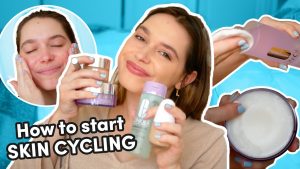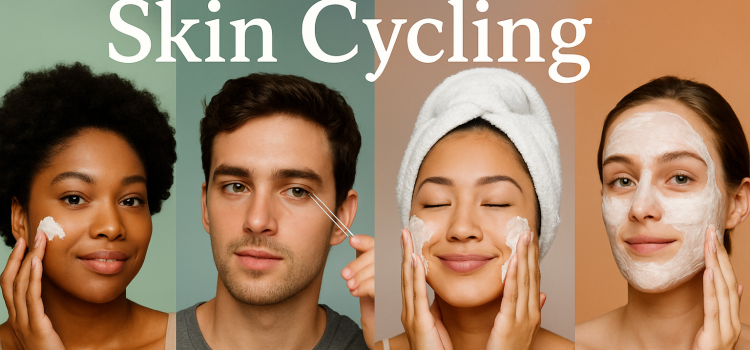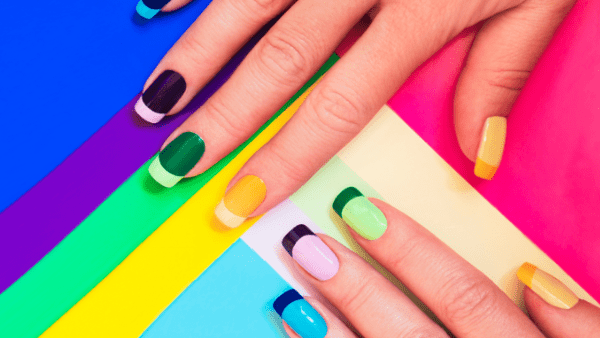
Introduction
Every day, we see new products promising flawless skin. Yet, using too many creams and serums can overwhelm your face. Instead of piling on products, experts now recommend skin cycling. This method spreads out key ingredients over a few nights. The idea is to balance active treatments with recovery time. By doing this, your skin can heal and stay healthy without irritation.
A proper skincare routine should work with your skin’s natural cycle. With skin cycling, you apply active ingredients like retinol and exfoliation products on specific nights. Then you give your skin a break with gentle hydrating treatments. This simple schedule helps you get the best results from each item. By following a clear plan, you avoid overloading your skin.
In this article, you will learn what skin cycling is and why it matters. We will cover its benefits, show you how to implement skin cycling, share helpful tips, and point out common mistakes to avoid. You will even find a clear table that lays out a four-night cycle. By the end, you will be ready to revamp your skincare routine and achieve healthier, glowing skin.
What Is Skin Cycling?

Skin cycling is a method that spaces out powerful skincare treatments over several nights. The goal is to let your skin absorb and process each ingredient fully. Instead of applying retinol every night, you use it once, then take a break to let your skin recover. This cycle helps avoid dryness, redness, and irritation.
The typical cycle follows four steps:
- Exfoliation night
- Retinol night
- Recovery night (hydration)
- Another recovery night (hydration or gentle treatment)
On exfoliation night, you use a mild acid or enzyme-based product. This helps remove dead skin cells and unclog pores. On retinol night, you apply a retinol serum or cream. Retinol boosts cell turnover and helps with skin rejuvenation. The next two nights focus on hydration and repair. You use gentle creams and masks to soothe the skin, allowing it to rest.
By grouping these treatments, you give your skin the chance to rebuild and strengthen. Each step supports a different part of the skin’s cycle. Over time, you see fewer breakouts, smoother texture, and a brighter complexion. Nighttime skincare becomes more effective because you are not fighting with your skin’s natural repair process.
Benefits of Skin Cycling

Adopting skin cycling in your skincare routine offers many skin rejuvenation benefits:
- Balanced Treatment: When you spread out active ingredients, you avoid irritation. Your skin gets a full night to react to retinol or exfoliants. This balance prevents dryness and redness.
- Improved Absorption: By using fewer products each night, your skin can absorb each ingredient better. This deep absorption maximizes the power of retinol and acids. The result is more efficient results.
- Reduced Irritation: Many people feel stinging or redness from strong treatments. Skin cycling gives your skin time to calm down between active ingredients. That reduces flakiness and over-exfoliation.
- Enhanced Repair: Every cycle has two recovery nights, focusing on hydration. These nights let your skin repair damage and build a healthy barrier. A strong barrier means better defense against environmental stress.
- Consistent Results: Because you follow a clear schedule, you can track what works. If your skin reacts poorly to a product, you know when you used it. This consistency helps you fine-tune your routine.
- Anti-Aging Effects: Over time, regular use of retinol boosts collagen production. Retinol nights in the cycle help reduce fine lines and improve firmness. Recovery nights maintain skin moisture, preventing new wrinkles.
- Cost Efficiency: Instead of buying many products at once, you focus on a few key items. Over time, you invest in quality products for each step. This can save money and reduce waste in your skin drawer.
How to Implement Skin Cycling

Creating a skincare routine with skin cycling is simple. Follow these steps:
1. Exfoliation Night
Choose a gentle chemical exfoliant, such as a product with glycolic acid or lactic acid. Cleanse your face first. Apply the exfoliant evenly, avoiding the eye area. This removes dead skin cells and unclogs pores. Wait a few minutes, then follow with a hydrating serum. Finish with a moisturizer that contains ceramides or hyaluronic acid for hydration. Avoid using other actives this night.
2. Retinol Night
On the next night, use a retinol serum or cream. Start with a low-strength formula, like 0.25% tretinoin or over-the-counter retinol if you are a beginner. Cleanse your face and wait until it is fully dry (about 15 minutes). Apply a pea-sized amount of retinol. Follow with a moisturizer that soothes and locks in moisture. Retinol can make skin sensitive to sun, so be ready to use broad-spectrum sunscreen the next day.
3. Recovery Night (Hydration)
After retinol, your skin needs a break. On the third night, focus on hydration and repair. Use a gentle cleanser. Then apply a serum with hyaluronic acid or peptides. These ingredients draw moisture into the skin and help repair the barrier. Finally, use a thick cream or sleep mask to lock in moisture.
4. Another Recovery Night
The fourth night continues recovery. You can repeat the same hydration routine or add a gentle antioxidant serum, like a low-dose vitamin C serum. Make sure the antioxidant is not too strong. A mild formula can help protect your skin without causing irritation. End with a rich moisturizer to maintain a healthy skin barrier.
Comparative Table: Four-Night Skin Cycling Schedule
| Night | Main Focus | Key Products | Purpose |
|---|---|---|---|
| Night 1 | Exfoliation | Glycolic acid toner, lactic acid peel | Remove dead cells, smooth texture |
| Night 2 | Retinol | Retinol serum (0.25%–0.5%) | Boost collagen, speed cell turnover |
| Night 3 | Hydration & Repair | Hyaluronic acid serum, ceramide cream | Restore moisture, strengthen barrier |
| Night 4 | Hydration & Protection | Peptide serum, gentle antioxidant, rich moisturizer | Calm skin, support healing, prevent damage |
Conclusion
Skin cycling offers a fresh way to revamp your skin care routine. By spacing out exfoliation and retinol treatments, you let your skin recover fully from dark spots, sign of aging, acne prone skin, acne scarring and oily skin. Two hydration nights in each cycle keep your skin barrier strong. Over time, this balanced approach leads to fewer breakouts, smoother texture, and a brighter complexion. Avoid common mistakes by starting slow, patch testing new skincare products, and always using sunscreen. Track your progress to see how your skin responds. With consistency, you will enjoy healthier, radiant skin without irritation. Embrace improve skin cycling to maximize every skin care product’s potential and achieve your best glow yet.










